RM 1360 Twin keel
Sailboat specifications
The RM 1360 is a 44’7” (13.6m) fast cruising sailboat designed by Marc Lombard Yacht Design Group (France). She was built between 2013 and 2017 by Fora Marine (France). The Twin keel version allows a shallower draft while maintaining performance thanks to the asymmetric fins with bulb. As a bonus beaching becomes easy and stable.
The RM 1360 is as well listed, on Boat-Specs.com, in Fin keel version (see all the versions compared).
The RM 1360 is as well listed, on Boat-Specs.com, in Fin keel version (see all the versions compared).
RM 1360's main features
- Model
- RM 1360
- Version
- Twin keel
- Hull type
- Monohull
- Category
- Offshore fast cruising sailboat
- Sailboat builder
- Sailboat designer
- Sailboat range
- Country
- France
- Construction
- Hull and deck: plywood with glass/epoxy stratification
- First built hull
- 2013
- Last built hull
- 2017
- Appendages
- Twin keel : twin asymmetric fin with bulb
- Helm
- Twin helm wheels
- Rudder
- Single spade rudder (twin as option)
- Unsinkable
- No
- Trailerable
- No
- EC design categoryiThe CE design category indicates the ability to cope with certain weather conditions (the sailboat is designed for these conditions)
A: Wind < force 9, Waves < 10m
B: Wind < force 8, Waves < 8m
C: Wind < force 6, Waves < 4m
D: Wind < force 4, Waves < 0,5m - A
- Standard public price ex. VAT (indicative only)
- About283 000 €(2016)
RM 1360's main dimensions
- Hull length
- 44’ 7”13.6 m
- Waterline length
- 42’ 1”12.82 m
- Beam (width)
- 14’ 10”4.5 m
- Draft
- 6’ 5”1.95 m
- Mast height from DWL
- 67’ 4”20.51 m
- Light displacement (MLC)
- 20723 lb9400 kg
- Maximum displacement (MLDC)
- 27558 lb12500 kg
- Capacity
- 6834 lb3100 kg
- Ballast weight
- 6614 lb3000 kg
RM 1360's rig and sails
- Upwind sail area
- 1206 ft²112 m²
- Downwind sail area
- 2185 ft²203 m²
- Mainsail area
- 570 ft²53 m²
- Genoa area
- 635 ft²59 m²
- Staysail area
- 334 ft²31 m²
- Asymmetric spinnaker area
- 1615 ft²150 m²
- Rigging type
- Cutter Marconi 9/10
- Mast configuration
- Deck stepped mast
- Rotating spars
- No
- Number of levels of spreaders
- 2
- Spreaders angle
- Swept-back
- Spars construction
- Aluminum spars
- Standing rigging
- 1x19 strand wire discontinuous
RM 1360's performances
- Upwind sail area to displacementiThe ratio sail area to displacement is obtained by dividing the sail area by the boat's displaced volume to the power two-thirds.
The ratio sail area to displacement can be used to compare the relative sail plan of different sailboats no matter what their size.
Upwind: under 18 the ratio indicates a cruise oriented sailboat with limited performances especially in light wind, while over 25 it indicates a fast sailboat. - 271 ft²/T25.15 m²/T
- Downwind sail area to displacementiThe ratio sail area to displacement is obtained by dividing the sail area by the boat's displaced volume to the power two-thirds.
The ratio sail area to displacement can be used to compare the relative sail plan of different sailboats no matter what their size. - 491 ft²/T45.58 m²/T
- Displacement-length ratio (DLR)iThe Displacement Length Ratio (DLR) is a figure that points out the boat's weight compared to its waterline length. The DLR is obtained by dividing the boat's displacement in tons by the cube of one one-hundredth of the waterline length (in feet).
The DLR can be used to compare the relative mass of different sailboats no matter what their length:
a DLR less than 180 is indicative of a really light sailboat (race boat made for planning), while a DLR greater than 300 is indicative of a heavy cruising sailboat. - 126
- Ballast ratioiThe Ballast ratio is an indicator of stability; it is obtained by dividing the boat's displacement by the mass of the ballast. Since the stability depends also of the hull shapes and the position of the center of gravity, only the boats with similar ballast arrangements and hull shapes should be compared.
The higher the ballast ratio is, the greater is the stability. - 32 %
- Critical hull speediAs a ship moves in the water, it creates standing waves that oppose its movement. This effect increases dramatically the resistance when the boat reaches a speed-length ratio (speed-length ratio is the ratio between the speed in knots and the square root of the waterline length in feet) of about 1.2 (corresponding to a Froude Number of 0.35) . This very sharp rise in resistance, between speed-length ratio of 1.2 to 1.5, is insurmountable for heavy sailboats and so becomes an apparent barrier. This leads to the concept of "hull speed".
The hull speed is obtained by multiplying the square root of the waterline length (in feet) by 1.34. - 8.69 knots
RM 1360's auxiliary engine
- Engine(s)
- 1 inboard engine
- Engine(s) power
- 75 HP
- Fuel type
- Diesel
- Fuel tank capacity
- 87.2 gal330 liters
RM 1360's accommodations and layout
- Cockpit
- Closing aft cockpit with opening system
- Cabin(s)
- 3
- Berth(s) (min./max.)
- 6 / 8
- Head(s)
- 2
- Freshwater tank capacity
- 158.5 gal600 liters
- Maximum headroom
- 6’ 6”1.97 m
- Head headroom
- 6’ 4”1.91 m
RM 1360's saloon
- Maximum headroom
- 6’ 4”1.91 m
- Saloon table length
- 4’ 1”1.25 m
- Saloon table width
- 2’ 5”0.74 m
- Berth length
- 6’ 7”2 m
- Chart table
- 3’ 2”0.99 m x 1’ 10”0.56 m
- Berth width
- 2’ 1”0.65 m
RM 1360's fore cabin
- Maximum headroom
- 6’ 4”1.92 m
- Berth length
- 6’ 7”2 m
- Berth width
- 5’ 1”1.56 m
RM 1360's aft cabin
- Maximum headroom
- 7’2.13 m
- Berth length
- 6’ 7”2 m
- Berth width
- 4’ 6”1.38 m

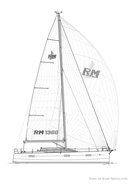

Fora Marine RM 1360 sailplan - - 2/19
Picture extracted from the commercial documentation © Fora Marine
Picture extracted from the commercial documentation © Fora Marine


Fora Marine RM 1360 layout - - 3/19
Picture extracted from the commercial documentation © Fora Marine
Picture extracted from the commercial documentation © Fora Marine


Fora Marine RM 1360 sailing - - 4/19
Picture extracted from the commercial documentation © Fora Marine
Picture extracted from the commercial documentation © Fora Marine


Fora Marine RM 1360 sailing - - 5/19
Picture extracted from the commercial documentation © Fora Marine
Picture extracted from the commercial documentation © Fora Marine


Fora Marine RM 1360 sailing - - 6/19
Picture extracted from the commercial documentation © Fora Marine
Picture extracted from the commercial documentation © Fora Marine


Fora Marine RM 1360 sailing - - 7/19
Picture extracted from the commercial documentation © Fora Marine
Picture extracted from the commercial documentation © Fora Marine
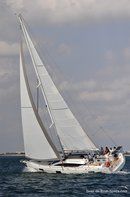

Fora Marine RM 1360 sailing - - 8/19
Picture extracted from the commercial documentation © Fora Marine
Picture extracted from the commercial documentation © Fora Marine
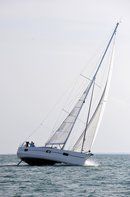

Fora Marine RM 1360 sailing - - 9/19
Picture extracted from the commercial documentation © Fora Marine
Picture extracted from the commercial documentation © Fora Marine


Fora Marine RM 1360 cockpit - - 10/19
Picture extracted from the commercial documentation © Fora Marine
Picture extracted from the commercial documentation © Fora Marine


Fora Marine RM 1360 interior and accommodations - - 11/19
Picture extracted from the commercial documentation © Fora Marine
Picture extracted from the commercial documentation © Fora Marine


Fora Marine RM 1360 interior and accommodations - - 12/19
Picture extracted from the commercial documentation © Fora Marine
Picture extracted from the commercial documentation © Fora Marine


Fora Marine RM 1360 interior and accommodations - - 13/19
Picture extracted from the commercial documentation © Fora Marine
Picture extracted from the commercial documentation © Fora Marine
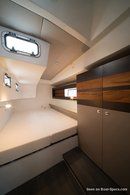

Fora Marine RM 1360 interior and accommodations - - 14/19
Picture extracted from the commercial documentation © Fora Marine
Picture extracted from the commercial documentation © Fora Marine


Fora Marine RM 1360 interior and accommodations - - 15/19
Picture extracted from the commercial documentation © Fora Marine
Picture extracted from the commercial documentation © Fora Marine
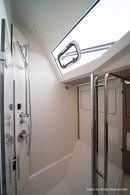

Fora Marine RM 1360 interior and accommodations - - 16/19
Picture extracted from the commercial documentation © Fora Marine
Picture extracted from the commercial documentation © Fora Marine


Fora Marine RM 1360 interior and accommodations - - 17/19
Picture extracted from the commercial documentation © Fora Marine
Picture extracted from the commercial documentation © Fora Marine


Fora Marine RM 1360 detail - - 18/19
Picture extracted from the commercial documentation © Fora Marine
Picture extracted from the commercial documentation © Fora Marine


Fora Marine RM 1360 detail - - 19/19
Picture extracted from the commercial documentation © Fora Marine
Picture extracted from the commercial documentation © Fora Marine
Similar sailboats that may interest you:
Sailboats
First built hull
Hull length
2008
44’ 7”13.6 m
2013
44’ 7”13.6 m
2008
45’ 6”13.86 m
2014
45’ 11”14 m
1998
34’ 5”10.47 m
1988
52’ 6”16 m
2003
39’ 4”11.99 m
2016
45’ 4”13.8 m
2015
39’ 10”12.12 m
2016
31’ 8”9.65 m
2017
40’12.2 m
2017
50’ 11”15.51 m
2017
44’ 11”13.68 m
2019
38’ 8”11.8 m
2015
35’ 1”10.69 m